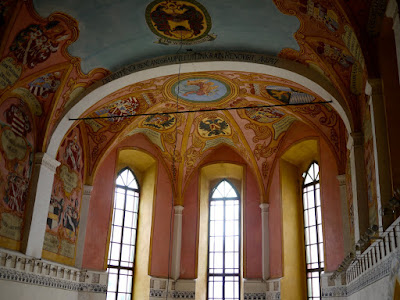One of our main reasons for coming to Ljubljana was that we had read that it had a good number of Art Nouveau buildings. After a bit of Googling we found this walk on the website of the Slovenia Life magazine.
The reason for there being such a clutch of buildings is that there was an earthquake in 1895 and the mayor of Ljubljana gave key projects to architects who were influenced by the Vienna Secessionist style. It seems that Art Nouveau, Secession, Jugenstil and Style Liberty can all be used interchangeably.
The walk begins towards the upper end of Ljubljana's main thoroughfares, Slovenska Cesta with the twin Apartment Houses of the Agricultural Loan Bank by Ciril Metod Koch. The green and yellow flower motifs over the windows are especially lovely.

You turn right along Cigaletova ulica and admire two contrasting houses on opposite sides of a cross roads. Pirc House dates from 1905-06 with its green and gold decoration and strong verticals.

Opposite is the Cuden (Cudnova) House by Ciril Metod Koch, which has a complimentary tower with a Secessionist orb on top and wavy line decorations and much more elaborate use of gold under the cornice.

Round the corner in Dalmatinksa ulica is the battered but wonderful Robert Smielenski's house of 1903. It features a more geometric approach to decoration.

Now you come back into Slovenska cesta and turn right into Tavcarjeva ulica. The house on the corner, the Hribar House, built for the mayor, has a lovely undulating facade with gold lion heads.
Next door is the Vodnik house. It is unfortunately in a poor state of repair, but the frieze and flower panels are quite lovely.

You pass between the Pirc and Cuden Houses into the small Miklosicev trg (square). On the right hand corner ahead is another building with a corner tower - the Krisper House of 1901 by Maks Fabiani. The corner tower was copied by the architects of the other two buildings. Krisper House is currently being restored. The botanical decoration along the line of the second floor windows flows along the full length of the house, is wonderfully fluid and is accentuated by semi-abstract bright blue dots.

Further along Tavcarjeva, number 11 has a wonderful flowery frieze at the top of the facade.

Now you return to the corner where the Krisper House is and turn right down Miklosiceva. The Bamberg House on the left has charming ceramic reliefs of male heads just under the cornice.
A short way further along you reach the extraordinary Cooperative Bank, built by Ivan Vernik in 1922. He was apparently intent on developing a Slovenian national style of architecture. It is not really clear to me that this building should be understood as being in the Art Nouveau style.

You pass the original entrance to the Union Hotel (1903-05) on the right and then on the left, as Miklosiceva joins Presernic trg, is Centromerkur, built 1902-04 as the first department store in Ljubljana. An elaborate restoration seems to be nearing completion.

Diagonally opposite is the Hauptman House, built in 1875 but renovated by Ciril Metod Koch in 1904. Its colourful exterior is now looking a bit faded.

Finally, just up Copova is the City Savings Bank of 1903-04 which features the last remaining original Art Nouveau sign board in the city.

Conditions: dry, bright.
Distance: 1.5 miles.
Rating: four stars, full of interest. A very well designed route too.









































